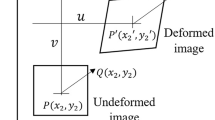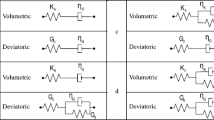Abstract
We developed a new numerical method which converts creep data to dynamic moduli without relying on viscoelastic spectra of relaxation or retardation times. This algorithm is an improvement of the previous ones (Kwon et al., 2016) in the reduction of artificial waviness in the terminal regime as well as the noise due to measurement errors. The method is the application of the point-wise polynomial regression which reduces the polynomial order dramatically compared with previous method in order to suppress the waviness.
Similar content being viewed by others
References
Baravian, C. and D. Quemada, 1998, Using Instrumental Inertia in Controlled Stress Rheometry, Rheol. Acta 37, 223–233.
Cho, K.S. and G.W. Park, 2013, Fixed Point Iteration for Relaxation Spectrum from Dynamic Mechanical Data, J. Rheol. 57, 647–678.
Cho, K.S., 2016, Viscoelasticity of Polymers: Numerical Methods, Springer.
Cho, K.S., M.K. Kwon, J. Lee, and S. Kim, 2017, Mathematical Analysis on Linear Viscoelastic Identification, Korea-Aust. Rheol. J. 29, 249–268.
Eckstein, A., J. Suhm, C. Friedrich, R.-D. Maier, J. Sassmannshausen, M. Bochmann, and R. Mülhaupt, 1998, Determination of Plateau Moduli and Entanglement Molecular Weights of Isotactic, Syndiotactic, and Atactic Polypropylenes Synthesized with Metallocene Catalysts, Macromolecules 31, 1335–1340.
Evans, R.M.L., M. Tassieri, D. Auhl, and T.A. Waigh, 2009, Direct Conversion of Rheological Compliance Measurements into Storage and Loss moduli, Phys. Rev. E 80, 012501.
Havriliak, S. and S. Negami, 1967, A Complex Plane Representation of Dielectric Mechanical Relaxation Processes in Some Polymers, Polymer 8, 161–210.
He, C., P. Wood-Adams, and J.M. Dealy, 2004, Broad Frequency Range Characterization of Molten Polymers, J. Rheol. 48, 711–724.
Honerkamp, J. and J. Weese, 1993, A nonlinear regularization method for the calculation of relaxation spectra, Rheol. Acta 32, 65–79.
Moreno-Guerra, J.A., I.C. Romero-Sánchez, A. Martinez-Borquez, M. Tassieri, E. Stiakakis, and M. Laurati, 2019, Model-Free Rheo-AFM Probes the Viscoelasticity of Tunable DNA Soft Colloids, Small 15, 1904136.
Kim, M., J.-E. Bae, N. Kang, and K.S. Cho, 2015, Extraction of Viscoelastic Functions from Creep Data with Ringing, J. Rheol. 59, 237–252.
Kwon, M.K., S.H. Lee, S.G. Lee, and K.S. Cho, 2016, Direct Conversion of Creep Data to Dynamic Moduli, J. Rheol. 60, 1181–1197.
Lee, S.H., J.-E. Bae, and K.S. Cho, 2017, Determination of Continuous Relaxation Spectrum Based on the Fuoss-Kirkwood Relation and Logarithmic Orthogonal Power-Series Approximation, Korea-Aust. Rheol. J. 29(2), 115–127.
Plazek, D.J., N. Raghupathi, and S.J. Orbon, 1979, Determination of Dynamic Storage and Loss Compliances from Creep Data, J. Rheol. 23, 477–488.
Pourahmadi, M., 1984, Taylor expansion of and some applications, Am. Math. Monthly 91, 303–307.
Schwarzl, F.R., 1969, The Numerical Calculation of Storage and Loss Compliance from Creep Data for Linear Viscoelastic Materials, Rheol. Acta 8, 6–17.
Tassieri, M., R.M.L. Evans, R.L. Warren, N.J. Bailey, and J.M. Cooper, 2012, Microrheology with Optical Tweezers: Data Analysis, New J. Phys. 14, 115032.
Tassieri, M., M. Laurati, D.J. Curtis, D.W. Auhl, S. Coppola, A. Scalfati, K. Hawkins, P.R. Williams, and J.M. Cooper, 2016, i-Rheo: Measuring the Material’s Linear Viscoelastic Properties “in a step”!, J. Rheol. 60, 649–660.
Tassieri, M., J. Ramirez, N.C. Karayiannis, S.K. Sukumaran, and Y. Masubuchi, 2018, i-Rheo GT: Transforming from Time to Frequency Domain without Artifacts, Macromolecules 51, 5055–5068.
Acknowledgements
This work was supported by the Mid-Career Researcher Program through the National Research Foundation of Korea (NRF) funded by the Ministry of Education, Science and Technology (2017R1A2B1005506).
Author information
Authors and Affiliations
Corresponding author
Additional information
Publisher’s Note
Springer Nature remains neutral with regard to jurisdictional claims in published maps and institutional affiliations.
Rights and permissions
About this article
Cite this article
Kim, S., Lee, J. & Cho, K.S. Direct conversion of creep data to dynamic moduli using point-wise method. Korea-Aust. Rheol. J. 33, 105–112 (2021). https://doi.org/10.1007/s13367-021-0009-x
Received:
Revised:
Accepted:
Published:
Issue Date:
DOI: https://doi.org/10.1007/s13367-021-0009-x




